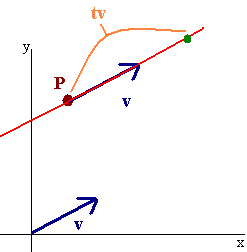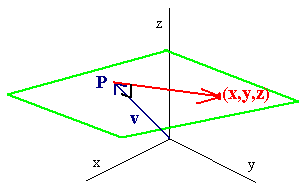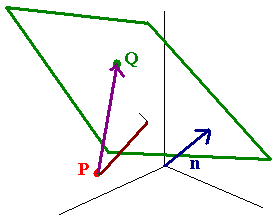1.6: Lines and Planes
( \newcommand{\kernel}{\mathrm{null}\,}\)
Lines
Our goal is to come up with the equation of a line given a vector v parallel to the line and a point (a,b,c) on the line. The figure (shown in 2D for simplicity) shows that if P is a point on the line then
⟨x,y⟩=P+tv
for some number t.

The picture is the same for 3D. The formula is given below.
The parametric equations for the line through the point (a,b,c) and parallel to the vector v are
⟨x,y,z⟩=⟨a,b,c⟩+tv.
Find the parametric equations of the line that passes through the point (1,2,3) and is parallel to the vector ⟨4,−2,1⟩.
Solution
We write:
⟨x,y,z⟩=⟨1,2,3⟩+t⟨4,−2,1⟩=⟨1+4t,2−2t,3+t⟩
or
x(t)=1+4t,
y(t)=2−2t,
z(t)=3+t.
Find the parametric equations of the line through the two points (2,1,7) and (1,3,5).
Hint: a vector parallel to the line has tail at (2,1,7) and head at (1,3,5).
Planes
If S is a plane then a vector n is normal (perpendicular) to the plane if it is orthogonal to every vector that lies on the plane. Suppose that n is a normal vector to a plane and (a,b,c) is a point on the plane. Let (x,y,z) be a general point on the plane, then
⟨x−a,y−b,z−c⟩
is parallel to the plane, hence
→n⋅⟨x−a,y−b,z−c⟩=0.
This defines the equation of the plane.

Find the equation of the plane that contains the point (2,1,0) and has normal vector ⟨1,2,3⟩.
Solution
We have
⟨1,2,3⟩⋅⟨x−2,y−1,z−0⟩=0
so that
1(x−2)+2(y−1)+3z=0
or
x+2y+3z=4.
Find the equation of the plane through the points
- P=(0,0,1)
- Q=(2,1,0)
- R=(1,1,1)
Solution
Let
v=Q−P=⟨2,1,−1⟩
and
w=R−P=⟨1,1,0⟩
then to find a vector normal to the plane, we find the cross product of v and w:
v×w=|ˆiˆiˆi21−1110|=ˆi−ˆj+ˆk
or
⟨1,−1,1⟩.
We can now use the formula:
⟨1,−1,1⟩⋅⟨x,y,z−1⟩=0
or
x−y+z−1=0
or
x−y+z=1
Distance Between a Point and a Plane
Let P be a point and Q be a point on a plane with normal vector n, then the distance between P and the plane is given by
Let Q be a point on the plane with normal vector →n. The the distance from the point P to this plane is given by
ProjnPQ=||PQ⋅→n||||→n||.
Find the distance between the point (1,2,3) and the plane
2x−y−2z=5.
Solution
The normal vector can be read off from the equation as
→n=⟨2,−1,−2⟩.

Now find a convenient point on the plane such as Q=(0,−5,0). We have
Q=⟨−1,−7,−3⟩
and
→n⋅PQ=−2+7+6=11.
We find the magnitude of n by taking the square root of the sum of the squares. The sum is
4+1+4=9
so
||→n||=3.
Hence the distance from the point to the plane is 113.
The Angle Between Two Planes
The angle between two planes is given by the angle between the normal vectors.
Find the angle between the two planes
3x−2y+5z=1
and
4x+2y−z=4.
We have the two normal vectors are
→n=⟨3,−2,5⟩
and
→m=⟨4,2,−1⟩.
We have
→n⋅→m=3
||→n||=√38
||→m||=√21
hence the angle is
cos−1(3√38√21)=1.46rad.


